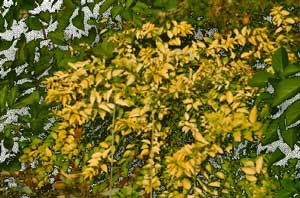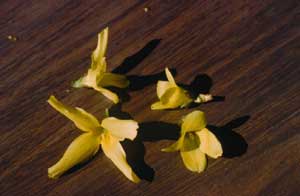Forsythia (Forsythia x intermedia)
 |
Forsythias are showy flowering shrubs from the Orient, introduced to America about 100 years ago. They are a familiar, early blooming herald of spring, their arching branches covered with yellow blossoms just preceding the emergence of their leaves. Border forsythia (Forsythia x intermedia) is one of the most popular kinds of forsythia. Like most, it tolerates city conditions better than most other decorative shrubs, and it has few serious insect or disease problems. With proper care, these shrubs can live for 50 to 60 years.
Border forsythias thrive throughout the South. They are found northward as far as the southern and coastal regions of New England and through most of the U.S. except for the Great Plains and west coast (zone 4). They are hardy in areas where the winter temperature can be counted on not to drop much below -10°F.
Size: If they are not pruned, border forsythias may grow to 8 feet tall and 5 feet wide in five years. In 10 years they will reach 12 feet by 8 feet; and after 20 years, 13 feet by 12 feet. Multi-stemmed shrubs, their arching branches billow out, causing more mature shrubs to grow almost as wide as they are tall.
Foliage: Forsythias are deciduous; their medium green leaves turn brown or purplish and fall off in October. Individual leaves are shaped like elongated ovals and have toothed edges. They average 3 to 4 inches in length and are arranged opposite each other along the branches. Some kinds of forsythias have variegated foliage of cream and green others have yellow or golden leaves.
 |
Flowers : Border forsythias bear one inch lemon to golden-yellow bell-shaped flowers along their bare branches in March and April. They have no scent. Buds for the next season, form on the current season's branches at the end of the summer. A few border forsythia varieties have small greenish-yellow flowers. Forsythia fruits are inconspicuous dry capsules.

